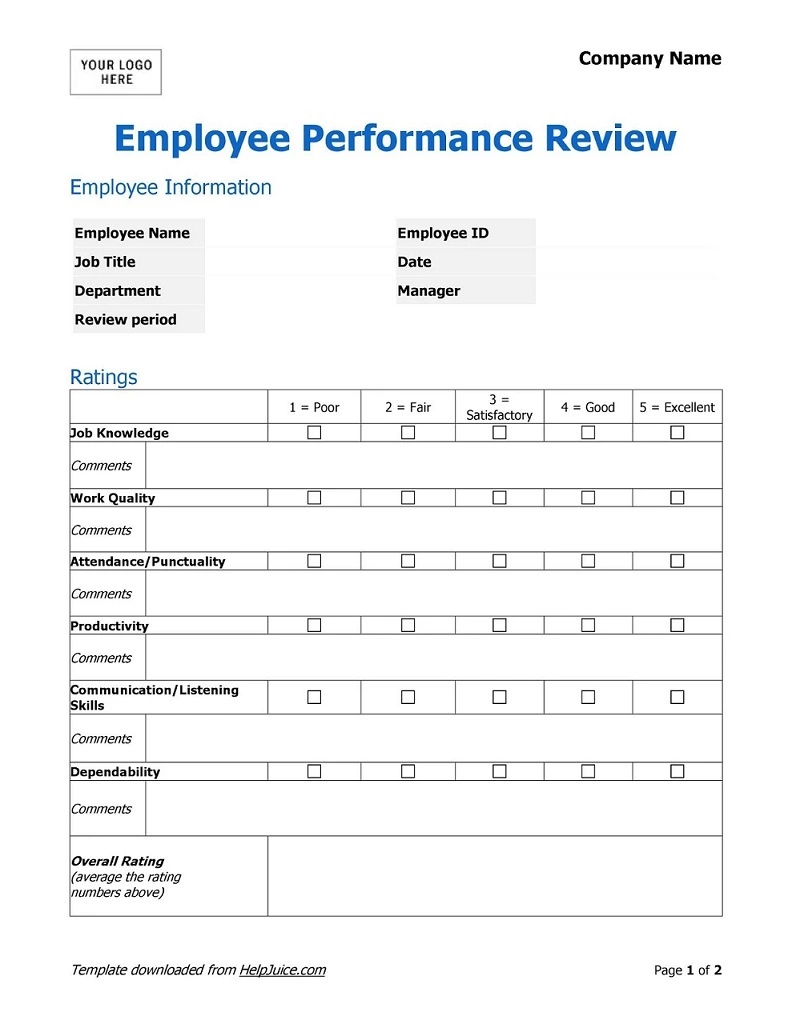
The traditional employee evaluation process is often criticized and it’s no secret that many managers and employees dislike it.
“To evaluate or not to evaluate?”
That is the question many business leaders ask these days. The answer, however, is much more nuanced than a simple Yes or No.
No matter how awkward it may be to give negative assessments, it’s still essential to create a feedback loop for your employees.
Most workers want to know if they are doing a good job—accurate feedback makes 68% of employees feel fulfilled at work.
Also, according to a survey by Zenger and Folkman, 92% of employees believe that “negative (redirecting) feedback, if delivered appropriately, is effective at improving performance.”
So, employee performance evaluation is important to your employees. Why does it have so many critics?
Performance evaluation isn’t the culprit here. It’s the way you conduct it.
To quote Cynthia Flynn from Hackler Flynn & Associates:
“The key is planning a proper employee evaluation process that will positively impact both employees and supervisors.”
What is the Purpose of Employee Evaluations?
- Recognize good performers: According to employees, job/performance recognition is the number one motivator for them to produce their best work.
- Identify future business leaders: Timely employee evaluation and robust feedback mechanisms help you identify good candidates for upward mobility.
- Support underachieving workers: Job performance reviews are the best time to suggest employee training and development programs to your struggling workers.
- Set expectations for future job performance: You can work with the employee to set goals and priorities. Research shows that this is a way to give employees more freedom in meeting the objectives and allow them to take initiative.
- Measure goal progress: Employee evaluation is a map (of sorts), which helps employees and managers understand how far they’ve come during a specific time period.
- Inform important decisions: Performance evaluations function as traceable documentation that can be used to make decisions regarding pay raise, promotions and other benefits.
- Defend your decisions: An employee assessment report gives you a legally valid reason to fire an employee who has a history of underperforming.
- Evaluate recruitment and onboarding practices: Assessing the performance of new hires can help you understand the effectiveness of your hiring and onboarding practices.
- Align day-to-day work with business goals: According to SHRM, performance management is the one thing that “drives employee behavior to align with organizational goals and objectives”.
Employee Evaluation vs Performance Appraisal
Strictly speaking, an employee evaluation is focused on providing feedback about the employee’s job performance, punctuality, behavior, leadership ability, etc.
A performance appraisal, on the other hand, examines whether the employee’s efforts are in-tune with the company’s goals and if the employee is a good fit for the company.
The former is operational, while the latter is strategic.
In the second edition of the Encyclopedia of Business, however, ‘Employee Evaluation and Performance Appraisal’ are grouped together and considered synonyms in most contexts.
How to Conduct an Effective Employee Evaluation?
1. Understand the employee’s duties to set objective criteria
The work evaluation process starts by outlining the criteria and procedures used to assess the employee’s performance.
According to Adam Hempenstall, CEO and Founder of Better Proposals, “The best practice when it comes to evaluation is to have a deep understanding of the work being done and what it means to be successful in a certain role.”
He gives the example of a designer. “…you may think that a designer should be able to finish a landing page per day, but in reality, it's far from the truth. So, first, get to know the role and then get to know the person doing the job - how they work and how much they can do in a day or a week. Then set your standards for evaluation.”
Both positive and negative feedback should be provided, along with personalized remarks and suggestions for improvements. Managers should avoid writing about anything that has not expressly been discussed with the employee during the face-to-face meeting.
2. Set your evaluation frequency right
65% of employees stated that they would feel happier and more confident if their managers had more frequent feedback sessions with them.
But the unfortunate truth is that 19% of employees receive job performance feedback only once a year.
One way to avoid this is to supplement your annual performance evaluation with real-time feedback, e.g. conduct 10-15 minute monthly catch-ups.
Companies like Accenture, Adobe, Deloitte, Gap, and Microsoft have already upgraded their performance management processes to ensure each worker receives feedback on a regular basis.
At the very least, Carol Kardas, SHRM-SCP and Founding Partner of KardasLarson suggests that "managers reach out to their subordinates on a quarterly basis and check in to see how the employees are working toward achieving their goals for the year to prevent any surprises during the annual performance review."
Regardless of your evaluation frequency, ensure that your employees understand how the entire review process will be held, when and where.
3. Choose the right evaluator
Traditionally, job performance reviews use a single-rater evaluation system.
In this case, the immediate manager is the best person to conduct the assessment because he or she constantly communicates with the employee, understands the roles and responsibilities and the employee's working style.
A potential downside of this evaluation system is that the review can be biased.
Another approach is the multi-rater evaluation system or 360-degree performance review.
If this is the evaluation system you prefer, seek feedback from the employee's direct reports, internal/external business partners and customers.
Ideally, the evaluators in this case should have worked with the employee directly for a minimum of 4-6 months.

(Source)
4. Prepare an employee evaluation form
At the very least, your employee evaluation form should contain a written appraisal with specific, actionable comments and clear future goals.
It’s a good practice to include a section or an accompanying form for self-assessment because this enables the employee to reflect on his or her performance.
As Julie Wilson, Ed.M., Co-Founder and President of Academic Leadership Group points out, "ask your employees to reflect on their goals and then ask them to reflect on what kind of feedback, and from whom, will help them achieve those goals."
 General employee performance review template
General employee performance review template
One of the big questions here is this:
Should you use open-ended questions or a rating system such as a Likert Scale?
According to Ellen Mullarkey, VP of Business Development at Messina Staffing, “Standardized rubrics are good, and every employee evaluation should include one. This allows the company to assess each employee according to the same criteria, which is helpful for HR.
However, employee evaluations should also include some comments written specifically for the employee. Whether they’re positive, negative, or neutral, this personalized the assessment. It’s a great way to commend employees for outstanding work or to offer constructive criticism.”
So, yes, it’s a good idea to include personalized remarks and suggestions for improvements.
How to assess performance objectively?
Use the same evaluation form and criteria for all employees who are in the same position.
This will help you standardize the evaluation process and increase its accuracy. Then, set your own expectations right by understanding the inherent strengths, weaknesses, skill sets, and attitudes of each worker.
Keep in mind that outside factors such as personal issues, work environment and stress can affect performance, too.
According to Dr. Karen M. Leonard, Professor of Management at the University of Arkansas Little Rock:
“While doing this process, remember that people with the best attitude and intent may not be successful if the environment is not good (e.g., there is bullying, the temperature is too extreme, noise interferes) or if the resources are not available (e.g., lack of time, lack of training, lack of technology or appropriate tools).”
5. Schedule a face-to-face meeting
One-on-one, face-to-face feedback sessions are more personal and create an atmosphere of trust between employees and managers.
To make sure the employee has enough time to prepare, schedule a date and time for the review well in advance.
During the meeting, Professor Leonard suggests to follow these steps:
“Write the review in relation to the mutual discussion.
Let the employee review the evaluation.
Sign the evaluation and ask the employee to sign it. If the employee does not agree with the evaluation, make sure that s/he has an opportunity to write a rebuttal.”
Don’t forget to be honest about your negative feedback. As we pointed out earlier, the majority of employees embrace negative feedback if it’s delivered with respect and enables them to improve.
As Carla Howard, owner of The Professional Woman's Mentor, says, “It is much easier to give negative feedback when you let the person know that you care about them and their development.”
6. Have clear policies and procedures
A written employee assessment can potentially cause legal trouble, so it's crucial that all employees understand your process in detail.
Explain what the assessment will entail, state your performance measurement criteria and avoid any ambiguity.
After the review, clarify any employee evaluation questions and hand a copy of the signed evaluation form to the worker.
According to Cynthia Flynn from Hackler Flynn & Associates, “Companies should develop an evaluation handbook that explains the procedures for employee evaluations.”
Now that you know how to conduct a performance review, let’s go over the best practices.
Best Practices When Conducting Employee Evaluations
- Be candid. Don’t sugarcoat negative feedback and highlight issues that you feel may affect your employee’s career at the company. Cynthia Flynn says, “…providing employees with honest feedback and direction promotes efficiency and increases morale that can translate to improved profitability in the workplace.”
- Be consistent. As Carla Howard stresses, “Never surprise your employees with negative feedback. Have regular 1:1's, discuss what the employee is doing well and where you see opportunities for improvement.”
- Have data on hand. To inform your evaluation, collect peer feedback, examples of good and bad performance, performance metrics, etc.
- Stay focused. Don’t try to address multiple concerns in one sitting. Instead, focus on a key area of improvement that will have the biggest impact on the employee’s performance and career.
- Make it a two-way discussion. Listen to what the employee has to say and suggest ways to improve performance. As PHR Emeritus Timothy G. Wiedman of Doane University says, “If improvement is necessary, part of the discussion should be about improvement strategies that might be used in the future. But again, this must be a true 2-way discussion -- not the boss merely lecturing to the employee.”
- Set expectations. Be transparent and make sure employees understand the future roles and responsibilities they’re expected to handle.
- Close on a positive note. Show employees that you care about their future development and offer your help.
What Happens at the End of the Employee Evaluation Process?
When employees are meeting or exceeding your standards:
- Make sure they are recognized and rewarded for their efforts
- Suggest opportunities for career advancement
- Recommend training to further their professional development
- Encourage them to take on more responsibilities
When the employees are not meeting your standards
- Identify what causes poor performance—are they missing skills, motivation, tools or something else?
- Develop a Performance Improvement Plan with clear goals for the next work evaluation
- Provide the right training and resources they need to improve their performance
- If appropriate, shift their responsibilities or assign tasks that are better suited to their skills and abilities
- Help the employee feel motivated to succeed
Wrapping Up Employee Evaluation
Employee evaluation can be a complex process but it’s well worth the time investment.
As Cynthia Flynn puts it, “Too often evaluations are considered painful and time consuming. However, they are an important opportunity to provide employees with constructive feedback.”
When you involve the employee in the process and follow a standardized set of procedures, you ensure there are no biases or inaccuracies in your evaluation.
As a result, your employees receive the feedback and support they need to excel at their jobs.


